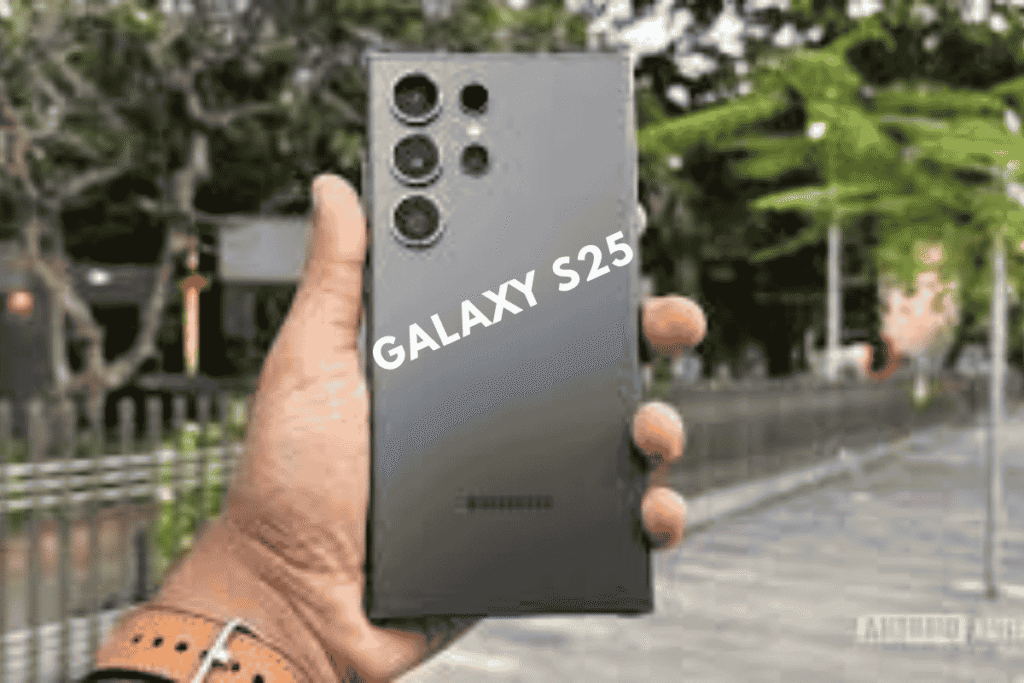
Hello people! Are the 2025 Smartphones Rewriting Innovation? Samsung’s Galaxy Ultra series has remained at the top of the Android series through the effective use of high technology and an impressive interface. Currently, mobile phone companies face serious competition, as other brands are also advancing rapidly. In 2025, many competitors are set to compete with , each featuring things that distinguish them from others. We examine how Samsung’s most significant competitors are preparing to match or surpass the features of their next-generation phones, while also striving to lead the smartphone industry.
As the years pass, Samsung finds itself competing with new threats emerging in the cell phone market. Thanks to its impressive features, attractive designs, and low prices, this brand is making news.
Today we shall dive right in!
Galaxy S25 Ultra Tops List

Within this month alone, they have released a new model of the Galaxy S25 Audio into the market, and it is already performing well compared to the expected performance of its counterparts. The S25 Ultra can build upon the achievements of its predecessors, featuring a soft form, a rigid brass framework, and glare-less glasses created by Corning. The S series continues to feature the in-built S Pen as its primary selling point, along with an IP68 dustproof and waterproof rating.
The S25 Ultra is equipped with a Qualcomm Snapdragon 8 Elite processor, comprising an octa-core central processing unit made using a 3nm chipset and an Adreno 830 graphics chip, which provides high performance and fast speed. It will come with 12GB of advanced LPDDR5X RAM and 1TB of storage. It features a 12MP front camera.
iPhone 17 Pro Max Challenge
Although the S25 Ultra excels, rival phones are pushing their limits and trying to find an area where they can stand out. Every year, Apple’s iPhone is a formidable challenger to Samsung; readers should expect the new iPhone 17 this September. The Pro Max version of the iPhone 17 is expected to reach the pinnacle of the line by introducing significant design and performance enhancements.
Rumours suggest a slimmer titanium frame, a smaller Dynamic Island to enhance the screen’s appearance, and an extra effort to improve cameras, particularly those used in low-light situations.
iPhone 17 Pro Max Advances
With the A19 Pro on a 2nm process, the iPhone 17 Pro Max is expected to perform and conserve energy very well when running AI applications directly on the device itself. More RAM is likely to be introduced in Apple models to enhance their multitasking capabilities and facilitate machine learning more effectively. People are saying the zoom lens for the iPhone 17 will be a modern periscope telephoto type, providing a smoother zoom effect.
- Every phone will feature a 24MP front camera, an upgrade from the 12MP cameras found on previous models.
- Due to improved efficiency and new battery technologies, the expected lifespan of a battery is expected to increase.
Google Pixel 10 Pro AI Innovator
With its Pixel series, Google is now famous for having the best computational photo technology and delivering pure Android. Sources indicate that the Pixel 10 Pro, slated for a 2025 release, will retain the bold horizontal camera stripe from its predecessors and highlight state-of-the-art AI features.
It hasn’t been confirmed how much storage the Pixel 10 Pro will use, but it appears to utilise Google’s Tensor G5 chip, a 3nm TSMC chip that accelerates AI processing on the device. You can expect Android 16 to be present, which means your device will come with the newest AI tools and significant enhancements to security.
Google Pixel’s AI Photography Power
The advanced computational photography engine, powered by Tensor G5, will likely help Google Skyline take better photos, correct skin tones, put Magic Editor at your fingertips, remove unwanted blur, and find your best shots. Brilliant AI is what enables the Pixel to make its user experience smarter and more natural, mainly in pictures and how its software runs.
Meet the Performance Leader

A Qualcomm Snapdragon 8 Elite (3nm) processor, created to deliver energy efficiency, drives the OnePlus 13. A key improvement is the 13 Ultra’s large 6,000 mAh Carbon Silicon battery, a significantly larger capacity than before. Quick charging is available, allowing you to use a 100W wired charger to reach a full battery in just 36 minutes, and the same applies to a 50W wireless charger.
The use of silicon-carbon technology in batteries enables a thinner design, allowing them to operate for several days at a time. A 6.82-inch AMOLED screen with HBM’s brightest peak at 4500 nits and a 120Hz refresh rate is included, plus Crystal Shield super-ceramic glass for protection.
OnePlus 13: Power and Precision
The phone camera on the OnePlus 13, in collaboration with Hasselblad, features a 50MP primary sensor, a 50MP periscope telephoto sensor offering 3x optical zoom, and a 50MP wide-angle sensor. You can take shots with a 32MP front camera. In case of its release, the OnePlus 13 Pro will take a step further by featuring three high-quality cameras: a 200MP, 48MP, and 50MP sensor, and will provide a 165Hz display refresh rate.
The company OnePlus offers fast, powerful hardware and rapid charging, which is an attractive characteristic for consumers and gamers.
Xiaomi 15 Ultra: The Innovator of Imaging
The idea of focusing on the quality of pictures in smartphones continues to gain momentum, with Xiaomi teaming up with top-level photographers, and most recently, Leica. Xiaomi launched the 15 Ultra on 11 March 2025, with a focus on delivering the best camera experience for its users. According to the company, the device will be straightforward to customise and operate with Android 15 and HyperOS 2.
Xiaomi’s Powerful Cameras and Charging
The phone’s superb image performance is a result of combining camera layouts and Leica’s colour and advanced computing capabilities. You can easily take stunning selfies because of the 32MP front camera. A 5410mAh battery with 90W wired and 80W wireless charging means this phone charges faster than most. If photography or monitoring your battery usage is essential, the cameras and powerful charging options offered by Xiaomi are easy to notice.
2025 Key Competitive Sectors
There will be many decisive battles for the top spot in smartphone technology in 2025.
AI-Powered Chips Drive Innovation
Among the top processors for mobile phones are Qualcomm’s Snapdragon 8 Elite, Apple’s A19 Pro, and Google’s Tensor G5. Most of these chips operate thanks to cutting-edge 3nm and 2nm technology, and include superior NPUs and DSPs designed for more demanding on-device artificial intelligence.
Using AI accelerators, machines will be able to process images effectively, translate languages in real-time, create highly personalised user experiences, and utilise generative AI, which will make them unique. Samsung’s Snapdragon 8 Elite and Google’s Tensor G5 are designed for deep AI, but Apple’s A19 Pro will make on-device AI solutions more potent for its system.
Next-Gen Displays Shine in 2025
Better Displays: 2025’s displays are not only brighter but also more efficient, making it easier to immerse yourself in your entertainment fully. Many of today’s displays, including the Samsung S25 Ultra, Google Pixel 10 Pro, and Xiaomi 15 Ultra, display so brightly that it’s easy to see even in direct sunlight.
Having an adaptive refresh rate (from 1Hz to 120Hz or 165Hz on the rumoured 13 Pro) on LTPO AMOLED displays makes the image look great and uses less battery. Some companies are developing foldable and rollable screen devices to offer users larger screens in more portable shapes. However, technologies are incorporated into various products. Materials for blue emitters continue to add to the longevity of OLED displays.
Powerful Batteries for Modern Demands
Since phones now feature 5G and fast displays with AI, battery performance remains a primary concern. In response to these concerns, manufacturers are now including large battery capacities (over 5000mAh) utilising silicon-carbon technology.
With the fast charging of up to 100W (according to some rumourss for OnePlus), 90W on Xiaomi and 80W wireless charging on Xiaomi, you’ll wait less time between charges When combined with powerful chipsets (3nm and 2nm), updated software also contribute to better battery life, aiming for smartphones to last two days easily.
Premium Phones Evolve in 2025
This trend is on the rise, with premium telephone sets (such as the Samsung S25 Ultra and iPhone 17 Pro Max) whose bodies are designed with titanium to make them hard yet extremely light. The models are so expensive that they require extra protection for their screens, such as Gorilla Glass Armor 2, Crystal Shield glass, or Xiaomi Shield 2.0.
Even though many people have simple phones, so-called slab and foldable gadgets, including the Samsung Z Fold and the rumored Pixel Fold 10, are catching a lot of attention from users who want something new.
Changing and Diverse Scenery

In 2025, Samsung’s competitors will be putting it down harder through greater quantities and variety. All the presidential candidates are valuable for their strengths.
The Apple iPhone 17 Pro Max is ideal for those who want seamless Apple services, protection of their privacy, and modern on-device AI capabilities, along with top-notch camera features.
Google Pixel 10 Pro
Those keen on getting Android as it ought to be, a real standout photograph, and AI functions now and in the future, will be its main users.
The OnePlus 13 Pro (and 13) will satisfy users who require the most outstanding features, rapid charging, and long battery life.
The camera is also one of the strongest features of the Xiaomi 15 Ultra, providing a favored experience among photography enthusiasts. It not only offers superior picture-taking capabilities but also offers the opportunity to utilize new photo utilities and quickly charge the phone.
Conclusion
The competition among premium smartphone groups is intensifying as we approach 2025. Although Samsung remains the industry leader with its new models, its competitors are also making significant strides through various innovative concepts. Besides its similar features, this is an improved competitor in terms of design, functionality, and price. They will have access to better technology and a large number of options at affordable prices.
To keep up with the pack in the flagship market, increasingly developers are improving the camera, boosting processors, and streamlining the experience. To survive, Samsung must continue to move forward, while new entrants should also innovate and improve. Can Samsung maintain its lead amid rising flagship competition?
FAQS
1. What company stands out as Samsung’s most serious smartphone competition in 2025?
The Google Pixel 9 Pro Max is a formidable rival to Samsung in terms of performance and innovative ideas.
2. Does the rival screen have higher quality than the Samsung Galaxy?
Samsung AODMOLED Panel proves to be brighter than Samsung’s counterpart.
3. Is this rival selling for less than Samsung’s latest models?
It sells for hundreds of dollars less than the Galaxy S25 Ultra.
4. How quickly does the rival update its software?
World’s first with seven updates guaranteed, identical to what Samsung offers.
5. Will Samsung’s future counterpart be called the champion of smartphone photography?
Sometimes, when there isn’t much light, it works a little better.




Leave a Reply